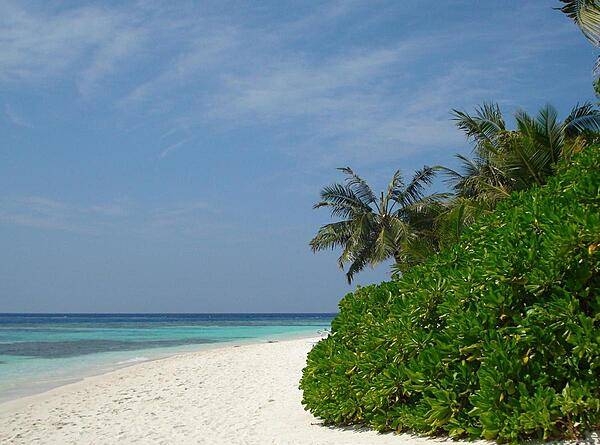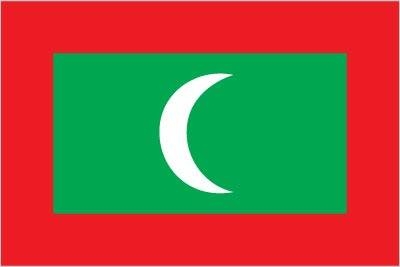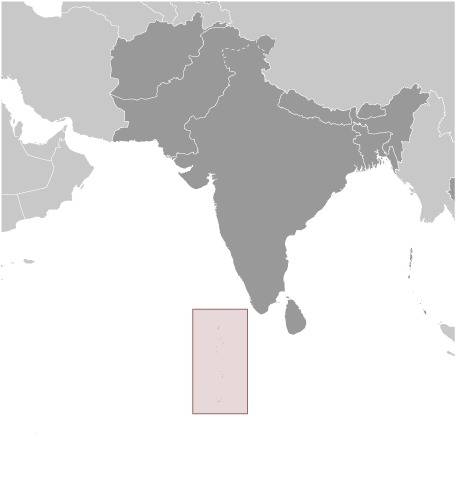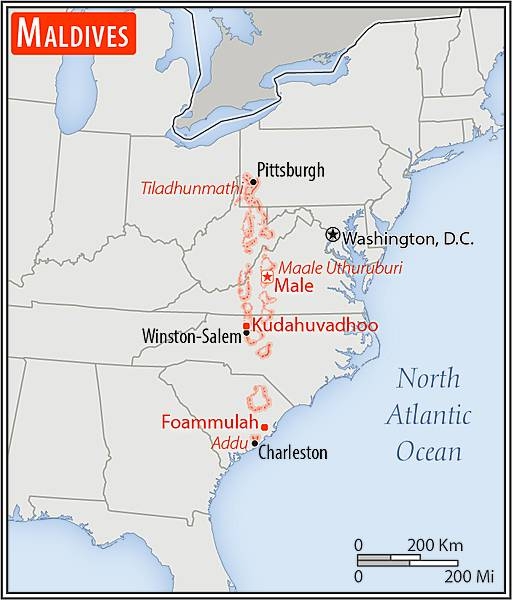Maldives
Introduction
Background
A sultanate since the 12th century, the Maldives became a British protectorate in 1887. The islands became a republic in 1968, three years after independence. President Maumoon Abdul GAYOOM dominated Maldives' political scene for 30 years, elected to six successive terms by single-party referendums. Following political demonstrations in the capital Male in August 2003, GAYOOM and his government pledged to embark upon a process of liberalization and democratic reforms, including a more representative political system and expanded political freedoms. Political parties were legalized in 2005.
In June 2008, a constituent assembly - termed the "Special Majlis" - finalized a new constitution ratified by GAYOOM in August 2008. The first-ever presidential elections under a multi-candidate, multi-party system were held in October 2008. GAYOOM was defeated in a runoff poll by Mohamed NASHEED, a political activist who had been jailed several years earlier by the GAYOOM regime. In early February 2012, after several weeks of street protests in response to his ordering the arrest of a top judge, NASHEED purportedly resigned the presidency and handed over power to Vice President Mohammed WAHEED Hassan Maniku. A government-appointed Commission of National Inquiry concluded there was no evidence of a coup, but NASHEED contends that police and military personnel forced him to resign. NASHEED, WAHEED, and Abdulla YAMEEN Abdul Gayoom ran in the 2013 elections with YAMEEN ultimately winning the presidency after three rounds of voting. As president, YAMEEN weakened democratic institutions, curtailed civil liberties, jailed his political opponents, restricted the press, and exerted control over the judiciary to strengthen his hold on power and limit dissent. In September 2018, YAMEEN lost his reelection bid to Ibrahim Mohamed SOLIH, a parliamentarian of the Maldivian Democratic Party (MDP), who had the support of a coalition of four parties that came together to defeat YAMEEN and restore democratic norms to Maldives. In April 2019, SOLIH's MDP won 65 of 87 seats in parliament.
Visit the Definitions and Notes page to view a description of each topic.
Geography
Location
Southern Asia, group of atolls in the Indian Ocean, south-southwest of India
Geographic coordinates
3 15 N, 73 00 E
Map references
Asia
Land boundaries
total: 0 km
Coastline
644 km
Maritime claims
territorial sea: 12 nm
contiguous zone: 24 nm
exclusive economic zone: 200 nm
measured from claimed archipelagic straight baselines
Climate
tropical; hot, humid; dry, northeast monsoon (November to March); rainy, southwest monsoon (June to August)
Terrain
flat coral atolls, with white sandy beaches; sits atop the submarine volcanic Chagos-Laccadive Ridge
Elevation
highest point: 8th tee, golf course, Villingi Island 5 m
lowest point: Indian Ocean 0 m
mean elevation: 2 m
Land use
agricultural land: 23.3% (2018 est.)
arable land: 10% (2018 est.)
permanent crops: 10% (2018 est.)
permanent pasture: 3.3% (2018 est.)
forest: 3% (2018 est.)
other: 73.7% (2018 est.)
Irrigated land
0 sq km (2012)
Population distribution
about a third of the population lives in the centrally located capital city of Male and almost a tenth in southern Addu City; the remainder of the populace is spread over the 200 or so populated islands of the archipelago
Natural hazards
tsunamis; low elevation of islands makes them sensitive to sea level rise
Geography - note
smallest Asian country; archipelago of 1,190 coral islands grouped into 26 atolls (200 inhabited islands, plus 80 islands with tourist resorts); strategic location astride and along major sea lanes in Indian Ocean
People and Society
Nationality
noun: Maldivian(s)
adjective: Maldivian
Ethnic groups
homogeneous mixture of Sinhalese, Dravidian, Arab, Australasian, and African resulting from historical changes in regional hegemony over marine trade routes
Languages
Dhivehi (official, dialect of Sinhala, script derived from Arabic), English (spoken by most government officials)
Religions
Sunni Muslim (official)
Age structure
0-14 years: 22.13% (male 44,260/female 42,477)
15-24 years: 17.24% (male 37,826/female 29,745)
25-54 years: 48.91% (male 104,217/female 87,465)
55-64 years: 6.91% (male 12,942/female 14,123)
65 years and over: 4.81% (male 8,417/female 10,432) (2020 est.)
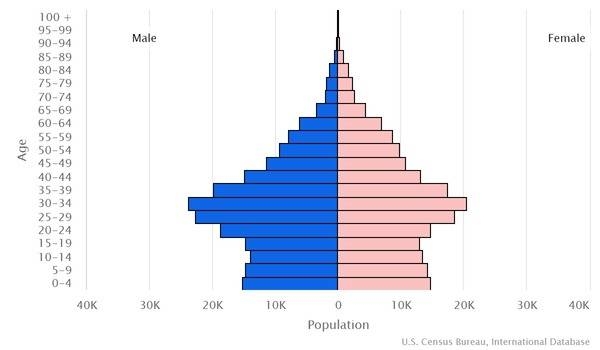
Dependency ratios
total dependency ratio: 35.6
youth dependency ratio: 29.5
elderly dependency ratio: 6.2
potential support ratio: 16.2 (2021 est.)
Median age
total: 29.5 years
male: 29.2 years
female: 30 years (2020 est.)
Net migration rate
-12.78 migrant(s)/1,000 population (2022 est.)
country comparison to the world: 226Population distribution
about a third of the population lives in the centrally located capital city of Male and almost a tenth in southern Addu City; the remainder of the populace is spread over the 200 or so populated islands of the archipelago
Urbanization
urban population: 42% of total population (2023)
rate of urbanization: 2.34% annual rate of change (2020-25 est.)
Major urban areas - population
177,000 MALE (capital) (2018)
Sex ratio
at birth: 1.05 male(s)/female
0-14 years: 1.04 male(s)/female
15-24 years: 1.2 male(s)/female
25-54 years: 1.11 male(s)/female
55-64 years: 0.89 male(s)/female
65 years and over: 0.75 male(s)/female
total population: 1.08 male(s)/female (2022 est.)
Mother's mean age at first birth
23.2 years (2016/17 est.)
note: data represents median age at first birth among women 25-49
Maternal mortality ratio
53 deaths/100,000 live births (2017 est.)
country comparison to the world: 92Infant mortality rate
total: 25.7 deaths/1,000 live births
male: 28.76 deaths/1,000 live births
female: 22.49 deaths/1,000 live births (2022 est.)
Life expectancy at birth
total population: 76.94 years
male: 74.57 years
female: 79.42 years (2022 est.)
Contraceptive prevalence rate
18.8% (2016/17)
Drinking water source
improved: urban: 99% of population
rural: 100% of population
total: 99.6% of population
unimproved: urban: 1% of population
rural: 0% of population
total: 0.4% of population (2020 est.)
Current health expenditure
8% of GDP (2019)
Physicians density
2.05 physicians/1,000 population (2019)
Hospital bed density
4.3 beds/1,000 population
Sanitation facility access
improved: urban: 100% of population
rural: 99.1% of population
total: 99.5% of population
unimproved: urban: 0% of population
rural: 0.9% of population
total: 0.5% of population (2020 est.)
Alcohol consumption per capita
total: 1.38 liters of pure alcohol (2019 est.)
beer: 0.33 liters of pure alcohol (2019 est.)
wine: 0.59 liters of pure alcohol (2019 est.)
spirits: 0.45 liters of pure alcohol (2019 est.)
other alcohols: 0 liters of pure alcohol (2019 est.)
Tobacco use
total: 25.2% (2020 est.)
male: 44.4% (2020 est.)
female: 6% (2020 est.)
Child marriage
women married by age 15: 0%
women married by age 18: 2.2%
men married by age 18: 2.2% (2017 est.)
Literacy
definition: age 15 and over can read and write
total population: 97.7%
male: 97.3%
female: 98.1% (2016)
School life expectancy (primary to tertiary education)
total: 13 years
male: 12 years
female: 14 years (2019)
Youth unemployment rate (ages 15-24)
total: 13.9%
male: 9.7%
female: 17.2% (2019 est.)
Environment
Environment - current issues
rising sea levels threaten land; depletion of freshwater aquifers threatens water supplies; inadequate sewage treatment; coral reef bleaching
Environment - international agreements
party to: Biodiversity, Climate Change, Climate Change-Kyoto Protocol, Climate Change-Paris Agreement, Comprehensive Nuclear Test Ban, Desertification, Endangered Species, Hazardous Wastes, Law of the Sea, Ozone Layer Protection, Ship Pollution
signed, but not ratified: none of the selected agreements
Air pollutants
particulate matter emissions: 7.63 micrograms per cubic meter (2016 est.)
carbon dioxide emissions: 1.44 megatons (2016 est.)
methane emissions: 0.14 megatons (2020 est.)
Climate
tropical; hot, humid; dry, northeast monsoon (November to March); rainy, southwest monsoon (June to August)
Land use
agricultural land: 23.3% (2018 est.)
arable land: 10% (2018 est.)
permanent crops: 10% (2018 est.)
permanent pasture: 3.3% (2018 est.)
forest: 3% (2018 est.)
other: 73.7% (2018 est.)
Urbanization
urban population: 42% of total population (2023)
rate of urbanization: 2.34% annual rate of change (2020-25 est.)
Revenue from forest resources
forest revenues: 0% of GDP (2018 est.)
country comparison to the world: 183Waste and recycling
municipal solid waste generated annually: 211,506 tons (2015 est.)
Total water withdrawal
municipal: 5.6 million cubic meters (2017 est.)
industrial: 300,000 cubic meters (2017 est.)
agricultural: 0 cubic meters (2017 est.)
Total renewable water resources
30 million cubic meters (2017 est.)
Government
Country name
conventional long form: Republic of Maldives
conventional short form: Maldives
local long form: Dhivehi Raajjeyge Jumhooriyyaa
local short form: Dhivehi Raajje
etymology: archipelago apparently named after the main island (and capital) of Male; the word "Maldives" means "the islands (dives) of Male"; alternatively, the name may derive from the Sanskrit word "maladvipa" meaning "garland of islands"; Dhivehi Raajje in Dhivehi means "Kingdom of the Dhivehi people"
Government type
presidential republic
Capital
name: Male
geographic coordinates: 4 10 N, 73 30 E
time difference: UTC+5 (10 hours ahead of Washington, DC, during Standard Time)
etymology: derived from the Sanskrit word "mahaalay" meaning "big house"
Administrative divisions
21 administrative atolls (atholhuthah, singular - atholhu); Addu (Addu City), Ariatholhu Dhekunuburi (South Ari Atoll), Ariatholhu Uthuruburi (North Ari Atoll), Faadhippolhu, Felidhuatholhu (Felidhu Atoll), Fuvammulah, Hahdhunmathi, Huvadhuatholhu Dhekunuburi (South Huvadhu Atoll), Huvadhuatholhu Uthuruburi (North Huvadhu Atoll), Kolhumadulu, Maale (Male), Maaleatholhu (Male Atoll), Maalhosmadulu Dhekunuburi (South Maalhosmadulu), Maalhosmadulu Uthuruburi (North Maalhosmadulu), Miladhunmadulu Dhekunuburi (South Miladhunmadulu), Miladhunmadulu Uthuruburi (North Miladhunmadulu), Mulakatholhu (Mulaku Atoll), Nilandheatholhu Dhekunuburi (South Nilandhe Atoll), Nilandheatholhu Uthuruburi (North Nilandhe Atoll), Thiladhunmathee Dhekunuburi (South Thiladhunmathi), Thiladhunmathee Uthuruburi (North Thiladhunmathi)
Independence
26 July 1965 (from the UK)
National holiday
Independence Day, 26 July (1965)
Constitution
history: many previous; latest ratified 7 August 2008
amendments: proposed by Parliament; passage requires at least three-quarters majority vote by its membership and the signature of the president of the republic; passage of amendments to constitutional articles on rights and freedoms and the terms of office of Parliament and of the president also requires a majority vote in a referendum; amended 2015
Legal system
Islamic (sharia) legal system with English common law influences, primarily in commercial matters
International law organization participation
has not submitted an ICJ jurisdiction declaration; accepts ICCt jurisdiction
Citizenship
citizenship by birth: no
citizenship by descent only: at least one parent must be a citizen of Maldives
dual citizenship recognized: yes
residency requirement for naturalization: unknown
Suffrage
18 years of age; universal
Executive branch
chief of state: President Ibrahim "Ibu" Mohamed SOLIH (since 17 November 2018); Vice President Faisal NASEEM (since 17 November 2018); the president is both chief of state and head of government
head of government: President Ibrahim "Ibu" Mohamed SOLIH (since 17 November 2018); Vice President Faisal NASEEM (since 17 November 2018)
cabinet: Cabinet of Ministers appointed by the president, approved by Parliament
elections/appointments: president directly elected by absolute majority popular vote in 2 rounds if needed for a 5-year term (eligible for a second term); election last held on 23 September 2018 (next to be held in 2023)
election results: 2018: Ibrahim Mohamed SOLIH elected president (in the first round); Ibrahim Mohamed SOLIH (MDP) 58.3%, Abdulla YAMEEN Abdul Gayoom (PPM) 41.7%
Legislative branch
description: unicameral Parliament or People's Majlis (87 seats - includes 2 seats added by the Elections Commission in late 2018; members directly elected in single-seat constituencies by simple majority vote to serve 5-year terms)
elections: last held on 6 April 2019 (next to be held in 2023)
election results: percent of vote - MDP 44.7%, JP 10.8%, PPM 8.7%, PNC 6.4%, MDA 2.8%, other 5.6%, independent 21%; seats by party - MDP 65, JP 5, PPM 5, PNC 3, MDA 2, independent 7; composition - men 83, women 4, percent of women 4.6%
Judicial branch
highest court(s): Supreme Court (consists of the chief justice and 6 justices
judge selection and term of office: Supreme Court judges appointed by the president in consultation with the Judicial Service Commission - a 10-member body of selected high government officials and the public - and upon confirmation by voting members of the People's Majlis; judges serve until mandatory retirement at age 70
subordinate courts: High Court; Criminal, Civil, Family, Juvenile, and Drug Courts; Magistrate Courts (on each of the inhabited islands)
Political parties and leaders
Adhaalath (Justice) Party or AP [Sheikh Imran ABDULLA]
Dhivehi Rayyithunge Party or DRP [Abdulla JABIR]
Maldives Development Alliance or MDA [Ahmed Shiyam MOHAMED]
Maldivian Democratic Party or MDP [Mohamed NASHEED]
Maldives Labor and Social Democratic Party or MLSDP [Ahmed SHIHAM]
Maldives Third Way Democrats or MTD [Ahmed ADEEB]
Maumoon/Maldives Reform Movement or MRM [Ahmed Faris MAUMOON]
National Democratic Congress [Yousuf Maaniu]
People's National Congress or PNC [Abdul Raheem ABDULLA]
Progressive Party of Maldives or PPM [Abdulla YAMEEN]
Republican (Jumhooree) Party or JP [Qasim IBRAHIM]
International organization participation
ADB, AOSIS, C, CP, FAO, G-77, IBRD, ICAO, ICC (NGOs), ICCt, IDA, IDB, IFAD, IFC, IFRCS, ILO, IMF, IMO, Interpol, IOC, IOM, IPU, ITU, MIGA, NAM, OIC, OPCW, SAARC, SACEP, UN, UNCTAD, UNESCO, UNIDO, UNWTO, UPU, WCO, WHO, WIPO, WMO, WTO
Diplomatic representation in the US
chief of mission:
Maldives has no embassy in the US, but its Permanent Representative to the UN in New York, Thilmeeza HUSSAIN (since 8 July 2019), is accredited to the US and serves as ambassador
chancery: 801 Second Avenue, Suite 202E, New York, NY 10017
telephone: [1] (212) 599-6194; [1] (212) 599-6195
FAX: [1] (212) 661-6405
email address and website:
info@maldivesmission.com
http://www.maldivesmission.com/
Diplomatic representation from the US
embassy: the US does not have an embassy in Maldives; the US is in the process of opening an embassy in Maldives; as of March 2022, there is no US Ambassador to Maldives; until late 2021, the US Ambassador to Sri Lanka was also accredited to the Maldives
Flag description
red with a large green rectangle in the center bearing a vertical white crescent moon; the closed side of the crescent is on the hoist side of the flag; red recalls those who have sacrificed their lives in defense of their country, the green rectangle represents peace and prosperity, and the white crescent signifies Islam
National symbol(s)
coconut palm, yellowfin tuna; national colors: red, green, white
National anthem
name: "Gaumee Salaam" (National Salute)
lyrics/music: Mohamed Jameel DIDI/Wannakuwattawaduge DON AMARADEVA
note: lyrics adopted 1948, music adopted 1972; between 1948 and 1972, the lyrics were sung to the tune of "Auld Lang Syne"
Economy
Economic overview
Maldives has quickly become a middle-income country, driven by the rapid growth of its tourism and fisheries sectors, but the country still contends with a large and growing fiscal deficit. Infrastructure projects, largely funded by China, could add significantly to debt levels. Political turmoil and the declaration of a state of emergency in February 2018 led to the issuance of travel warnings by several countries whose citizens visit Maldives in significant numbers, but the overall impact on tourism revenue was unclear.
In 2015, Maldives’ Parliament passed a constitutional amendment legalizing foreign ownership of land; foreign land-buyers must reclaim at least 70% of the desired land from the ocean and invest at least $1 billion in a construction project approved by Parliament.
Diversifying the economy beyond tourism and fishing, reforming public finance, increasing employment opportunities, and combating corruption, cronyism, and a growing drug problem are near-term challenges facing the government. Over the longer term, Maldivian authorities worry about the impact of erosion and possible global warming on their low-lying country; 80% of the area is 1 meter or less above sea level.
Real GDP (purchasing power parity)
$7.05 billion (2020 est.)
$10.37 billion (2019 est.)
$9.69 billion (2018 est.)
note: data are in 2017 dollars
Real GDP growth rate
4.8% (2017 est.)
4.5% (2016 est.)
2.2% (2015 est.)
Real GDP per capita
$13,000 (2020 est.)
$19,500 (2019 est.)
$18,800 (2018 est.)
note: data are in 2017 dollars
GDP (official exchange rate)
$4.505 billion (2017 est.)
Inflation rate (consumer prices)
2.3% (2017 est.)
0.8% (2016 est.)
Credit ratings
Fitch rating: CCC (2020)
Moody's rating: B3 (2020)
note: The year refers to the year in which the current credit rating was first obtained.
GDP - composition, by sector of origin
agriculture: 3% (2015 est.)
industry: 16% (2015 est.)
services: 81% (2015 est.)
GDP - composition, by end use
household consumption: (2016 est.) NA
government consumption: (2016 est.) NA
investment in fixed capital: (2016 est.) NA
investment in inventories: (2016 est.) NA
exports of goods and services: 93.6% (2016 est.)
imports of goods and services: 89% (2016 est.)
Agricultural products
papayas, vegetables, roots/tubers nes, nuts, fruit, other meat, tomatoes, coconuts, bananas, maize
Industries
tourism, fish processing, shipping, boat building, coconut processing, woven mats, rope, handicrafts, coral and sand mining
Labor force - by occupation
agriculture: 7.7%
industry: 22.8%
services: 69.5% (2017 est.)
Youth unemployment rate (ages 15-24)
total: 13.9%
male: 9.7%
female: 17.2% (2019 est.)
Population below poverty line
8.2% (2016 est.)
Gini Index coefficient - distribution of family income
31.3 (2016 est.)
37.4 (2004 est.)
Household income or consumption by percentage share
lowest 10%: 1.2%
highest 10%: 33.3% (FY09/10)
Budget
revenues: 1.19 billion (2016 est.)
expenditures: 1.643 billion (2016 est.)
Fiscal year
calendar year
Current account balance
-$876 million (2017 est.)
-$1.033 billion (2016 est.)
Exports
$3.72 billion (2019 est.) note: data are in current year dollars
$3.58 billion (2018 est.) note: data are in current year dollars
Exports - partners
Thailand 24%, United States 13%, China 12%, France 11%, Germany 11%, Italy 5%, United Kingdom 5% (2019)
Exports - commodities
fish products, natural gas, scrap iron, jewelry, liquid pumps (2019)
Imports
$4.09 billion (2019 est.) note: data are in current year dollars
$4.1 billion (2018 est.) note: data are in current year dollars
Imports - partners
United Arab Emirates 24%, China 16%, Singapore 14%, India 11%, Malaysia 6%, Thailand 5% (2019)
Imports - commodities
refined petroleum, fruits, furniture, broadcasting equipment, lumber (2019)
Reserves of foreign exchange and gold
$477.9 million (31 December 2016 est.)
$575.8 million (31 December 2015 est.)
Debt - external
$848.8 million (31 December 2016 est.)
$696.2 million (31 December 2015 est.)
Exchange rates
rufiyaa (MVR) per US dollar -
15.42 (2017 est.)
15.35 (2016 est.)
Energy
Electricity access
electrification - total population: 100% (2020)
Electricity
installed generating capacity: 545,000 kW (2020 est.)
consumption: 586.5 million kWh (2019 est.)
exports: 0 kWh (2020 est.)
imports: 0 kWh (2020 est.)
transmission/distribution losses: 21 million kWh (2019 est.)
Electricity generation sources
fossil fuels: 99.6% of total installed capacity (2020 est.)
nuclear: 0% of total installed capacity (2020 est.)
solar: 0% of total installed capacity (2020 est.)
wind: 0.4% of total installed capacity (2020 est.)
hydroelectricity: 0% of total installed capacity (2020 est.)
tide and wave: 0% of total installed capacity (2020 est.)
geothermal: 0% of total installed capacity (2020 est.)
biomass and waste: 0% of total installed capacity (2020 est.)
Coal
production: 0 metric tons (2020 est.)
consumption: 0 metric tons (2020 est.)
exports: 0 metric tons (2020 est.)
imports: 0 metric tons (2020 est.)
proven reserves: 0 metric tons (2019 est.)
Petroleum
total petroleum production: 0 bbl/day (2021 est.)
refined petroleum consumption: 15,300 bbl/day (2019 est.)
crude oil and lease condensate exports: 0 bbl/day (2018 est.)
crude oil and lease condensate imports: 0 bbl/day (2018 est.)
crude oil estimated reserves: 0 barrels (2021 est.)
Natural gas
production: 0 cubic meters (2021 est.)
consumption: 0 cubic meters (2021 est.)
exports: 0 cubic meters (2021 est.)
imports: 0 cubic meters (2021 est.)
proven reserves: 0 cubic meters (2021 est.)
Carbon dioxide emissions
2.286 million metric tonnes of CO2 (2019 est.)
from coal and metallurgical coke: 0 metric tonnes of CO2 (2019 est.)
from petroleum and other liquids: 2.286 million metric tonnes of CO2 (2019 est.)
from consumed natural gas: 0 metric tonnes of CO2 (2019 est.)
Energy consumption per capita
59.69 million Btu/person (2019 est.)
country comparison to the world: 92Communications
Telephones - fixed lines
total subscriptions: 14,508 (2020 est.)
subscriptions per 100 inhabitants: 3 (2020 est.)
Telephones - mobile cellular
total subscriptions: 717,708 (2020 est.)
subscriptions per 100 inhabitants: 133 (2020 est.)
Telecommunication systems
general assessment: with its economy so heavily dependent on tourism, the Maldives has suffered heavy economic as well as health casualties during the pandemic; the country had a relatively short period of lock down and was willing to welcome visitors back as early as July 2020; but the effective shutdown of international air travel for most of the year resulted in the bottom falling out of the Maldives’ tourism industry, taking GDP down 32% in the process; the economy fared better in 2021, with a return to growth, yet it may still be a few years before the country’s key industries can return to the same level of prosperity that they previously enjoyed; the country’s high number of tourists and expatriate workers has inflated the penetration rate for mobile services, making it one of the highest in the world; that rate crashed in 2020 as demand for SIM cards (primarily prepaid) dried up; however, the number of contract subscribers increased as locals took advantage of competitive pricing offers from operators; everything now rests on a fast return to normality, with tourists helping to boost the nation’s coffers as well as buying up those prepaid SIM cards; with commercial 5G services already launched and fiber networks rapidly expanding around the country, the Maldives is primed to deliver world-class telecommunications services to its domestic and international customers (2021)
domestic: fixed-line is at nearly 3 per 100 persons and mobile-cellular subscriptions stands at nearly 133 per 100 persons (2020)
international: country code - 960; landing points for Dhiraagu Cable Network, NaSCOM, Dhiraagu-SLT Submarine Cable Networks and WARF submarine cables providing connections to 8 points in Maldives, India, and Sri Lanka; satellite earth station - 3 Intelsat (Indian Ocean) (2019)
note: the COVID-19 pandemic continues to have a significant impact on production and supply chains globally; since 2020, some aspects of the telecom sector have experienced a downturn, particularly in mobile device production; progress toward 5G implementation has resumed, as well as upgrades to infrastructure; consumer spending on telecom services has increased due to the surge in demand for capacity and bandwidth; the crucial nature of telecom services as a tool for work and school from home is still evident, and the spike in this area has seen growth opportunities for development of new tools and increased services
Broadcast media
state-owned radio and TV monopoly until recently; 4 state-operated and 7 privately owned TV stations and 4 state-operated and 7 privately owned radio stations (2019)
Internet users
total: 340,542 (2020 est.)
percent of population: 63% (2020 est.)
Broadband - fixed subscriptions
total: 63,685 (2020 est.)
subscriptions per 100 inhabitants: 12 (2020 est.)
Transportation
National air transport system
number of registered air carriers: 3 (2020)
inventory of registered aircraft operated by air carriers: 36
annual passenger traffic on registered air carriers: 1,147,247 (2018)
annual freight traffic on registered air carriers: 7.75 million (2018)
Airports - with paved runways
total: 7
over 3,047 m: 1
2,438 to 3,047 m: 1
1,524 to 2,437 m: 1
914 to 1,523 m: 4 (2021)
Airports - with unpaved runways
total: 2
914 to 1,523 m: 2 (2021)
Roadways
total: 93 km (2018)
paved: 93 km (2018) - 60 km in Malée; 16 km on Addu Atolis; 17 km on Laamu
note: island roads are mainly compacted coral
Merchant marine
total: 68
by type: general cargo 21, oil tanker 19, other 28 (2021)
Ports and terminals
major seaport(s): Male
Military and Security
Military and security forces
the Republic of Maldives has no distinct army, navy, or air force but a single security unit called the Maldives National Defense Force (MNDF) comprised of ground forces, an air element, a coastguard, a presidential security division, and a special protection group (2022)
note: the Maldives Police Service is responsible for internal security and reports to the Ministry of Home Affairs
Military expenditures
not available
Military and security service personnel strengths
approximately 2,500 personnel (2022)
Military equipment inventories and acquisitions
India has provided most of the equipment in the MNDF's inventory (2022)
Military service age and obligation
18-28 years of age for voluntary service; no conscription; 10th grade or equivalent education required; must not be a member of a political party (2022)
Military - note
the MNDF is primarily tasked to reinforce the Maldives Police Service and ensure security in the country's exclusive economic zone (2022)
Terrorism
Terrorist group(s)
Islamic State of Iraq and ash-Sham (ISIS)
note: details about the history, aims, leadership, organization, areas of operation, tactics, targets, weapons, size, and sources of support of the group(s) appear(s) in Appendix-T
